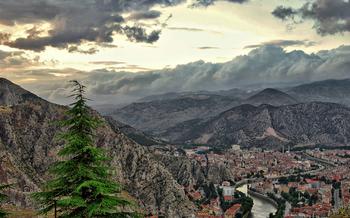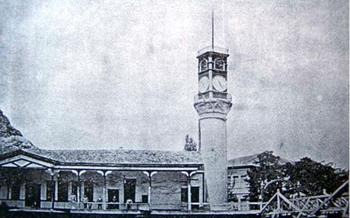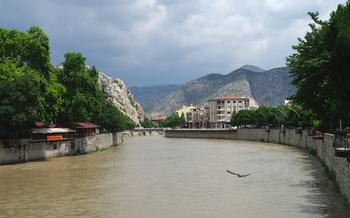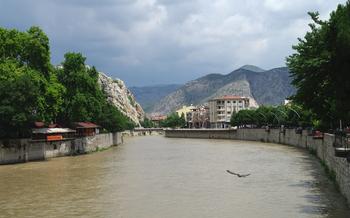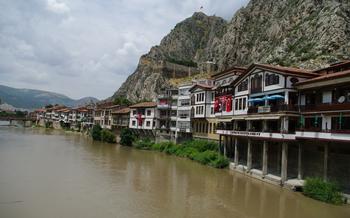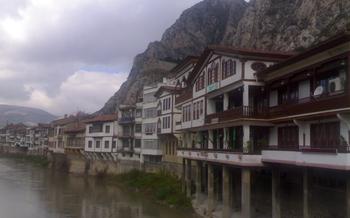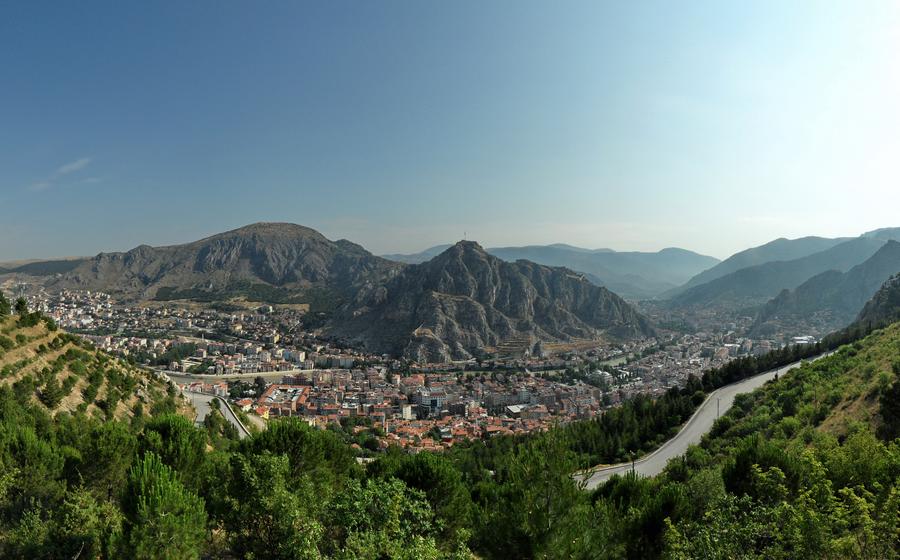
Bimarhane (Mental Hospital) Historical Museum
- Amasya Bimarhane: A Journey into History
- Location and Getting There
- Hours of Operation and Admission Fees
- Exploring the Museum's Exhibits
- Insights into Mental Health History
- Architectural Highlights
- Accessibility and Visitor Amenities
- Tips for Planning Your Visit
- Nearby Attractions
- Local Customs and Etiquette
- Safety and Security
- Sustainability and Environmental Responsibility
- Insider Tip: Discovering the Secret Garden
Amasya Bimarhane: A Journey into History
The Bimarhane, once a mental institution and now a historical museum, stands as a captivating testament to Amasya's rich past. Established in the 14th century, it served as a sanctuary for those struggling with mental health issues, offering refuge and care during a time when societal attitudes towards mental illness were vastly different.
The Bimarhane's architectural design reflects the unique blend of Ottoman and Seljuk styles, featuring intricate stonework, graceful arches, and serene courtyards. Its historical significance extends beyond its function as a mental health facility; it mirrors the evolving understanding of mental health treatment and the social context that shaped its establishment.
Preserving the Bimarhane as a cultural heritage site is of paramount importance. It serves as a tangible link to Amasya's past, showcasing the city's commitment to preserving its cultural identity and rich history. Moreover, its transformation into a museum has transformed it into a catalyst for promoting mental health awareness and dispelling the stigma surrounding mental illness.
Location and Getting There
The Bimarhane is conveniently located in the heart of Amasya, making it easily accessible for visitors. Its exact address is Bimarhane Caddesi, Amasya Merkez, 05100 Amasya, Turkey. To reach the Bimarhane, visitors can opt for public transportation, which offers regular bus services to the area. Taxis are also readily available and provide a comfortable and direct mode of transport. For those driving, the Bimarhane is easily accessible via the city's well-maintained road network. Ample parking facilities are available in the vicinity, ensuring a hassle-free visit. The Bimarhane is committed to accessibility and offers designated parking spaces for visitors with disabilities.
Hours of Operation and Admission Fees
The Bimarhane Historical Museum is open to the public daily, providing visitors with ample opportunities to explore its fascinating exhibits and learn about its rich history. The operating hours are as follows:
- Summer Season (April 1 to October 31): 08:30 AM to 19:00 PM
- Winter Season (November 1 to March 31): 08:30 AM to 17:30 PM
Admission to the museum is free of charge, making it accessible to visitors from all backgrounds. This free admission policy reflects the Bimarhane's commitment to promoting cultural heritage and mental health awareness to a broad audience.
Guided tours are available for those seeking a more in-depth experience. These tours are conducted by knowledgeable guides who provide insights into the Bimarhane's history, architecture, and significance. The cost of a guided tour is 10 Turkish Lira (TRY) per person.
For those planning a visit, online booking is available through the Bimarhane's official website. This convenient option allows visitors to secure their spot in advance, especially during peak tourist seasons.
Exploring the Museum's Exhibits
The Bimarhane Museum showcases a diverse range of permanent and temporary exhibitions that delve into the history of mental health treatment in Turkey. Permanent exhibits feature artifacts, historical documents, and interactive displays that shed light on the lives of patients and the various treatment methods employed at the institution. Visitors can gain a deeper understanding of the challenges faced by individuals with mental illness and the evolving attitudes towards mental health over time. Temporary exhibitions often focus on specific themes related to mental health, showcasing the latest research and insights from experts in the field. Through storytelling techniques and multisensory elements, the museum creates an immersive experience that allows visitors to connect with the past and reflect on the importance of mental well-being in society.
Insights into Mental Health History
The Bimarhane offers a unique perspective on the history of mental health treatment in Turkey. The exhibits provide an in-depth look at the various methods employed throughout the centuries, from traditional Ottoman practices to more modern approaches. Visitors can learn about the experiences of patients who resided in the Bimarhane, shedding light on their struggles and resilience. The museum also addresses the stigma surrounding mental illness and how the Bimarhane's transformation into a museum contributes to fostering acceptance and understanding. By exploring the history of mental health treatment at the Bimarhane, visitors gain a deeper appreciation for the challenges and triumphs of those affected by mental illness, promoting empathy and compassion.
Architectural Highlights
The Bimarhane showcases stunning Ottoman architecture, a testament to the rich cultural heritage of Amasya. The building's exterior features intricate stonework, arched entrances, and decorative tiles, reflecting the grandeur of Ottoman craftsmanship. Step inside to discover a series of wards arranged around a central courtyard, creating a serene and contemplative atmosphere. The wards, with their high ceilings and arched windows, once served as living quarters for patients. Explore further to find treatment facilities, such as hydrotherapy rooms and isolation cells, which provide insights into the historical methods of mental healthcare. The Bimarhane's architectural integrity has been meticulously preserved through careful restoration efforts, ensuring that its historical value and charm remain intact. The adaptive reuse of the building as a museum has allowed for the preservation and appreciation of its architectural heritage, transforming it into a living testament to the past.
Accessibility and Visitor Amenities
The Bimarhane is committed to providing an accessible and welcoming environment for all visitors. The museum features ramps, elevators, and accessible restrooms to ensure that visitors with disabilities can comfortably navigate the premises. Additionally, multi-language support is available through audio guides and translated materials, making the exhibits accessible to international visitors. The Bimarhane also offers a range of visitor amenities to enhance the overall experience. Visitors can browse the gift shop for souvenirs and historical artifacts, enjoy a refreshing beverage or snack at the café, or relax in the shaded outdoor resting areas. The museum staff is friendly and knowledgeable, providing assistance and guidance to ensure that every visitor has an enriching and enjoyable experience.
Tips for Planning Your Visit
To make the most of your visit to the Bimarhane, plan to spend at least an hour exploring the exhibits and grounds. Guided tours are available, offering a deeper insight into the history and significance of the institution. Photography is permitted, but flash photography and tripods are generally not allowed. Respectful attire is recommended, considering the historical and cultural nature of the site.
Nearby Attractions
A visit to the Bimarhane can be combined with other attractions in Amasya to create a well-rounded travel experience. History buffs can explore the Amasya Museum, which houses artifacts from the city's rich past, or visit the Kral Kaya Tombs, an ancient burial site with impressive rock-cut tombs. Nature lovers can stroll along the scenic Yeşilırmak River, which offers breathtaking views and opportunities for outdoor activities. For a taste of local culture, visitors can head to the vibrant Amasya Bazaar, where they can browse traditional Turkish handicrafts, savor delicious local cuisine, and interact with friendly locals.
Local Customs and Etiquette
When visiting Amasya and interacting with locals, it is essential to be mindful of cultural etiquette and customs. Amasya, like many other parts of Turkey, is a conservative city where traditional values are still upheld. Visitors should dress modestly and appropriately, especially when visiting religious sites or conservative areas. Revealing clothing or swimwear should be avoided in public spaces.
Respectful behavior is highly valued in Turkish culture. Greetings are typically accompanied by a handshake or a nod, and it is considered polite to maintain eye contact during conversations. When visiting local homes, it is customary to remove shoes before entering. Visitors should also be mindful of local customs regarding dining and social interactions, such as avoiding pointing their feet towards others or interrupting conversations.
To overcome language barriers, visitors can learn a few basic Turkish phrases or utilize translation apps. Locals are generally friendly and welcoming towards tourists, but they may not speak English fluently. Patience and understanding are key when communicating with locals who may not be proficient in English.
Safety and Security
Amasya is generally regarded as a safe city for travelers, but it's essential to remain vigilant and take necessary precautions. Emergency services, such as the police or medical assistance, are readily available, and contact information is easily accessible. Solo travelers, particularly women, should be mindful of their surroundings and avoid isolated areas at night. It is advisable to dress modestly and appropriately, respecting local customs and traditions. By being respectful and aware of your surroundings, you can ensure a safe and enjoyable visit to Amasya.
Sustainability and Environmental Responsibility
The Bimarhane is committed to embracing sustainable practices to minimize its environmental impact and promote responsible tourism. The museum has implemented measures such as waste reduction initiatives, energy-efficient lighting systems, and water conservation practices. Visitors are encouraged to adopt responsible tourism practices during their visit. Minimizing single-use plastics, supporting local businesses, and respecting the natural environment are ways travelers can contribute to the sustainability of the region. Recycling facilities are available on-site for visitors to dispose of their waste responsibly. By embracing sustainable practices, the Bimarhane aims to set a positive example and inspire visitors to become more environmentally conscious.
Insider Tip: Discovering the Secret Garden
Beyond the walls of the Bimarhane lies a hidden gem—a serene secret garden that offers a tranquil oasis amidst the historical grounds. Nestled away from the main exhibits, this secluded garden invites visitors to unwind and embrace the beauty of nature. With its lush greenery, fragrant flowers, and tranquil atmosphere, the garden provides a perfect spot for contemplation and reflection. Whether you seek a moment of solitude or a peaceful retreat, this hidden treasure is waiting to be explored, offering a unique and memorable experience for visitors to the Bimarhane.
